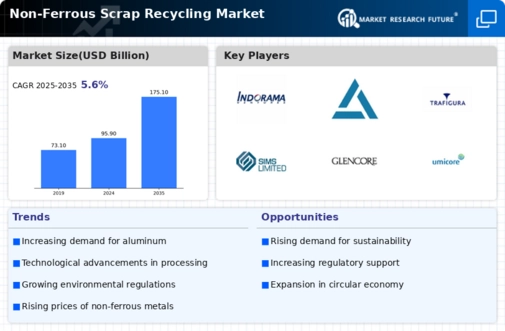Market Growth Projections
The Global Non-Ferrous Scrap Recycling Market Industry is projected to experience substantial growth over the next decade. With an estimated market value of 95.9 USD Billion in 2024, the industry is expected to expand significantly, reaching 175.1 USD Billion by 2035. This growth trajectory indicates a compound annual growth rate of 5.62% from 2025 to 2035. Factors contributing to this growth include increasing demand for recycled materials, advancements in recycling technologies, and supportive regulatory frameworks. The market's expansion reflects a broader shift towards sustainability and resource efficiency in various industries.
Rising Prices of Virgin Metals
The volatility in the prices of virgin metals is a significant factor influencing the Global Non-Ferrous Scrap Recycling Market Industry. As the costs of extracting and processing virgin metals fluctuate, the economic viability of recycling non-ferrous scrap becomes increasingly attractive. This price sensitivity encourages manufacturers to source recycled materials, thereby boosting demand in the recycling sector. The market's resilience is reflected in its projected growth, with expectations of reaching 95.9 USD Billion in 2024. As prices for virgin metals continue to rise, the recycling industry is likely to benefit from heightened interest in sustainable sourcing practices.
Growing Demand for Recycled Materials
The increasing global emphasis on sustainability drives the demand for recycled materials, particularly in the Global Non-Ferrous Scrap Recycling Market Industry. Industries such as automotive and construction are increasingly utilizing recycled non-ferrous metals to meet regulatory requirements and consumer preferences for eco-friendly products. This trend is expected to contribute to the market's growth, with the industry projected to reach 95.9 USD Billion in 2024. The shift towards circular economy practices further enhances the appeal of recycled materials, as companies seek to reduce their carbon footprint and reliance on virgin resources.
Regulatory Support for Recycling Initiatives
Government policies and regulations promoting recycling initiatives play a crucial role in shaping the Global Non-Ferrous Scrap Recycling Market Industry. Many countries are implementing stricter regulations on waste management and encouraging recycling through incentives and subsidies. This regulatory support fosters an environment conducive to the growth of the recycling sector, as businesses are motivated to invest in recycling infrastructure and technologies. The anticipated growth of the market, projected to reach 175.1 USD Billion by 2035, underscores the importance of these policies in driving the demand for non-ferrous scrap recycling.
Technological Advancements in Recycling Processes
Innovations in recycling technologies are significantly enhancing the efficiency and effectiveness of non-ferrous scrap recycling. The Global Non-Ferrous Scrap Recycling Market Industry benefits from advancements such as automated sorting systems and improved smelting techniques, which increase recovery rates and reduce operational costs. These technologies not only streamline the recycling process but also improve the quality of the recycled materials produced. As a result, the market is likely to experience robust growth, with a projected compound annual growth rate of 5.62% from 2025 to 2035, reflecting the increasing adoption of these advanced technologies.
Increasing Urbanization and Infrastructure Development
Urbanization and infrastructure development are key drivers of the Global Non-Ferrous Scrap Recycling Market Industry. As cities expand and new infrastructure projects emerge, the demand for non-ferrous metals rises, leading to increased scrap generation. This trend is particularly evident in developing regions, where rapid urban growth necessitates the use of recycled materials in construction and manufacturing. The market is poised for growth as urbanization continues, with the recycling of non-ferrous scrap becoming an essential component of sustainable development strategies. The industry's expansion aligns with global efforts to promote resource efficiency and reduce waste.












